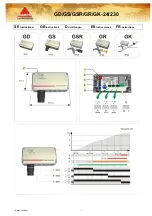
H25-IR PRO Instruction Manual
Glossary of Terms
P/N: 3015-5678 Rev 6
102
APPENDIX A: GLOSSARY OF TERMS
Table A-1. Glossary of Terms
Term
Description
alarm setpoint
A value of a measured quantity above which an alarm will occur. The H25-IR PRO has a
programmable alarm setpoint for the default user (User Setup 0) and for each of the four
custom users (User Setup 1-4). The alarm setpoint is a function of the measured gas reading.
You set the alarm setpoint for User Setup 0 from the Basic Setup Menu (see Alarm Setpoint on
page 49). Alarm Setpoints for User Setups 1-4 are set from the Advanced Setup Menu (see
Advanced Setup Screen on page 53 and Changing a User Setup Alarm Setpoint on page 58).
When the alarm setpoint is exceeded, the audible alarm will sound. In addition, output relays
may be programmed to energize if the alarm setpoint is exceeded (refer to Relay Connections
on page 30 and Table 5-21 on page 63).
ALQ
ä
ALQ
ä
(Advanced Leak Quantification) is a technology that eliminates the need to periodically
adjust the instrument to a calibrated reference leak source. The result is an instrument that
maintains its accuracy in real time, even under changing conditions. See Advanced Leak
Quantification (ALQ
ä
) Technology on page 6 for more information.
bar graph
See
graphic display
.
bump test
A bump test is a quick functional (not quantitative) test of the operation of a gas detector. It is
also used to test the internal and external alarm capabilities of the system. Compared to a
more complex
quantitative
test requiring a reference gas of precisely known quantity and
certified quality, a bump test may be accomplished with sample gas ampoules, or using
everyday items having similar molecular structure (therefore, recognized by the instrument’s
sensor). For example, depending on the type of gas sensor in your H25-IR PRO, you may be
able to perform a simple bump test using an uncapped permanent marker, typing correction
fluid, a can of aerosol spray used for dusting delicate computer components, or even a
disposable lighter (by just releasing the gas—not lighting it).
fault
A fault is an error. The H25-IR PRO can identify various faults and provide the operator with
feedback regarding the fault type and possible correction options. Refer to Fault Codes on
page 78 and page 101 for more information.
graphic display
Graphic display (or
bar graph
mode) is one of two display styles
from which the operator may choose for displaying the search
mode screen. (The other display style is numeric mode.) This user
preference is set from the Display Style option in the Basic Setup
menu (see Display Styles (Graphic vs. Numeric) on page 36, Basic
Setup Screen on page 45, and Display Style on page 51).
IR emitter
The IR (infrared) emitter is a component of the NDIR sensor. The emitter generates a focused
infrared beam through the gas sample and toward the detector. See
NDIR
sensor
for more
information.
IR detector
The IR (infrared) detector is a component of the NDIR sensor. The detector identifies how
much light (from the emitter) is getting through the tube (i.e., the amount of light NOT being
absorbed by the sample gas located in the tube). This is used to ultimately determine the leak
rate. See
NDIR sensor
for more information.
loop factor
Loop factor is a coefficient used for scaling the 4-20mA output to the input reading range (of
the sampled gas). Refer to Loop Factor on page 68 for additional information.
measure mode
Measure mode is one of two main operating modes of the H25-IR PRO. It is used to quantify a
leak rate and is typically use
after
using search mode to locate a leak.
Summary of Contents for H25-IR PRO
Page 6: ...H25 IR PRO Instruction Manual vi P N 3015 5678 Rev 6 ...
Page 8: ...H25 IR PRO Instruction Manual viii P N 3015 5678 Rev 6 ...
Page 39: ...H25 IR PRO Instruction Manual Menu System Overview P N 3015 5678 Rev 6 29 ...
Page 109: ...H25 IR PRO Instruction Manual Maintenance P N 3015 5678 Rev 6 99 ...
Page 120: ...H25 IR PRO Instruction Manual Declaration of Conformity P N 3015 5678 Rev 6 110 ...















































